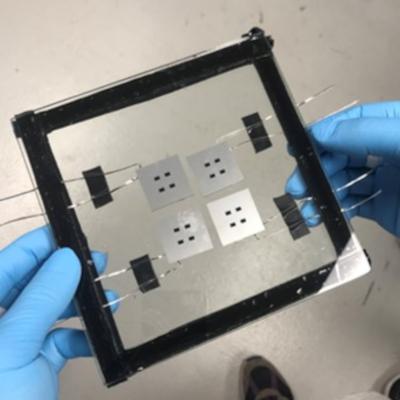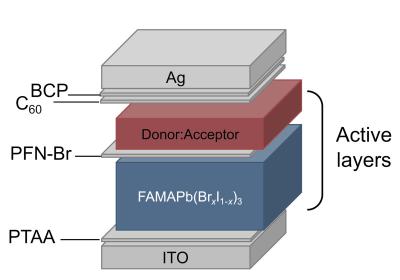Perovskite-Info weekly newsletter
Published: Tue, 02/21/23
The Perovskite-Info newsletter (February 21, 2023)
Cannot read this? View it online here
QD Solar announces efficient perovskite solar cells developed for large scale manufacturing
QD Solar, a Canada-based venture developing tandem solar technologies, has announced 3rd party-validated efficiencies of their single junction perovskite cells. The 24% efficiency for spin-coated perovskites cells and the 23.2% efficiency for slot-die coated, manufacturing-ready, perovskite cells have been officially confirmed by MKS Instruments/Newport in Utah, USA.
“The silicon-dominated solar industry is suffering from eroding single digit profit margins for the past decade due to fierce worldwide competition. This industry has also suffered from stagnated solar efficiencies, due to fundamental limitations related to the inherit physics of silicon. This industry demands the next generation of bankable solar materials. Deploying low-cost perovskite-based solar will allow our customers, the solar panel manufacturers, to charge premium prices on high-efficiency panels and double their profit margins. That’s huge for the solar industry,” says Dan Shea, CEO of QD Solar.
Researchers believe perovskite detectors could improve clinical X-ray imaging
A team of researchers from the X-ray Cancer Imaging and Therapy Experimental (XCITE) Lab at the University of Victoria in Canada set out to examine the potential of perovskite-based X-ray detectors. To do this, the team performed virtual clinical trials on next-generation perovskite detectors integrated into common X-ray imaging devices.
The team investigated the perovskite crystal methylammonium lead bromide (MAPbBr3), which combines high charge carrier mobility and long carrier lifetimes, making it extremely sensitive to incident X-ray photons. Indeed, some MAPbBr3 crystals show equivalent performance to that of cadmium zinc telluride (CZT), a promising material used in cutting edge medical imaging techniques such as photon-counting CT.
Researchers improve perovskite-based LEDs using self-assembled molecules
Researchers from the Institute of Chemical Research of Catalonia-The Barcelona Institute of Science and Technology (ICIQ-BIST), Centre Tecnològic de Catalunya EURECAT, Istituto Italiano di Tecnologia (IIT), ICREA and Universitat Rovira i Virgili have reported the application of two carbazole-based self-assembled molecules (SAMs) as hole injecting materials in perovskite-based LEDs.
Their structures differ in one phenyl ring in the bridge; however, the extra ring provides more stability to the devices, even surpassing the one obtained with the widely used polymer PTAA. In addition, due to the structural and electronic characteristics of the SAMs, the efficiency of the devices is also increased.
Researchers find special ingredient for stable and efficient inverted perovskite solar cells
Scientists from The University of Toledo, University of Washington, Northwestern University, University of Toronto and Empa–Swiss Federal Laboratories for Materials Science and Technology, have addressed a major challenge standing in the way of the commercialization of halide perovskite solar cells - their durability - by discovering an ingredient that enhances adhesion and mechanical toughness.
“Perovskite solar cells offer a route to lowering the cost of solar electricity given their high power conversion efficiencies and low manufacturing cost,” said Dr. Yanfa Yan, UToledo Distinguished University Professor of physics and a member of the UToledo Wright Center for Photovoltaics Innovation and Commercialization. “However, we needed to strengthen the emerging solar cell technology’s endurance during outdoor operation”. The technology needs to survive for decades outdoors in all kinds of weather and temperatures without corroding or breaking down.
Researchers report molecular engineering strategy for efficient and stable deep-red perovskite LEDs
Researchers from Purdue University, Florida State University, University of Kentucky, Lawrence Berkeley National Laboratory, University of Houston, Rice University, China's Qilu University of Technology (Shandong Academy of Sciences) and Taiwan's National Cheng Kung University have found that LEDs based on halide perovskites can produce more vivid, colorful and brighter images. The recent research presents extremely efficient perovskite LED devices in the red color region.
Perovskite materials often tend to be less stable and can degrade quickly. Further, device efficiency has not been fully optimized to compete with conventional LEDs. “Our work aims to resolve these critical issues,” said Purdue's Letian Dou, who conceived the idea, supervised the project and provided funding support.
Researchers increase the photoresponsivity of a lead-halide perovskite by 250%
Researchers from Korea's Institute for Basic Science (IBS), Chinese Academy of Sciences, the University of Rochester in the U.S, and The Australian National University have increased the photoresponsivity of a lead-halide perovskite for solar cell applications by 250%. They created a perovskite film with a plasmonic substrate made of hyperbolic metamaterial and characterized it with transition dipole orientation.
The team has considerably reduced electron recombination processes in lead-halide perovskites (LHPs) used for solar cell applications. Recombination can have a significant impact on electrical performance in perovskite cells, with implications for open-circuit voltage, short-circuit current, fill factor, and ultimately, power conversion efficiency.
Researchers develop efficient photodiode based on a tandem perovskite-organic solar cell architecture
Researchers from Eindhoven University of Technology and TNO at Holst Centre have developed a sensor that converts light into an electrical signal at an astonishing 200% efficiency – a seemingly impossible figure that was achieved through the exceptional nature of quantum physics.
SA schematic of the photodiode architecture
The team of scientists sees its invention potentially used in technology that monitors a person's vital signs (including heartbeat or respiration rate) from afar, without the need for anything to be inserted or even attached to the body.
Metalgrass LTD
9 Har Tsin St.
Kfar Sava Hasharon 4430809
ISRAEL
Unsubscribe | Change Subscriber Options









